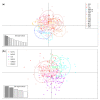Matching an Old Marine Paradigm: Limitless Connectivity in a Deep-Water Fish over a Large Distance
- PMID: 37684955
- PMCID: PMC10486518
- DOI: 10.3390/ani13172691
Matching an Old Marine Paradigm: Limitless Connectivity in a Deep-Water Fish over a Large Distance
Abstract
Investigations of population structuring in wild species are fundamental to complete the bigger picture defining their ecological and biological roles in the marine realm, to estimate their recovery capacity triggered by human disturbance and implement more efficient management strategies for fishery resources. The Blackspot Seabream (Pagellus bogaraveo, Brünnich 1768) is a commercially valuable deep-water fish highly exploited over past decades. Considering its exploitation status, deepening the knowledge of intraspecific variability, genetic diversity, and differentiation using high-performing molecular markers is considered an important step for a more effective stock assessment and fishery management. With one of the largest efforts conceived of and completed by countries overlooking the Atlantic and Mediterranean coasts in recent years, a total of 320 individuals were collected from different fishing grounds in the Mediterranean Sea and Atlantic Ocean and analysed using 29 microsatellite loci. We applied multiple statistical approaches to investigate the species' connectivity and population structure across most of its described distribution area. Considering the incomplete knowledge regarding the migratory behaviour of adults, here we suggest the importance of egg and larval dispersal in sustaining the observed genetic connectivity on such a large geographical scale.
Keywords: Blackspot Seabream; Pagellus bogaraveo; connectivity; fishery resource; microsatellite; population structure.
Conflict of interest statement
The authors declare no conflict of interest.
Figures



References
-
- Palumbi S.R. Genetic divergence, reproductive isolation, and marine speciation. Annu. Rev. Ecol. Syst. 1994;25:547–572. doi: 10.1146/annurev.es.25.110194.002555. - DOI
-
- Palumbi S.R. Molecular biogeography of the Pacific. Coral Reefs. 1997;16:S47–S52. doi: 10.1007/s003380050241. - DOI
-
- Palumbi S.R. Using genetics as an indirect estimator of larval dispersal. In: McEdward L., editor. Ecology of Marine Invertebrate Larvae. CRC Press; New York, NY, USA: 1995. pp. 369–387.
LinkOut - more resources
Full Text Sources
Miscellaneous

